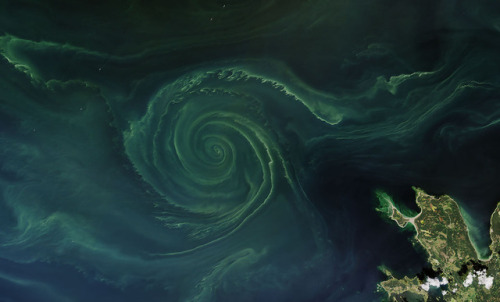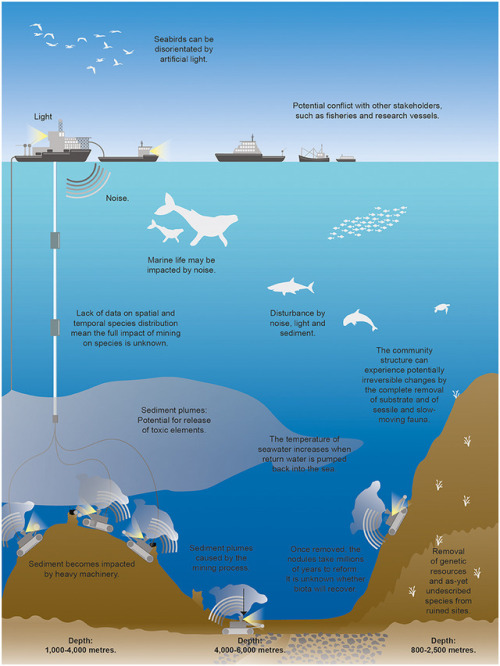NSF Cancels Grant Reviews Due To WH Executive Order
NSF cancels grant reviews due to WH executive order
The National Science Foundation (NSF)—the major funding agency for basic science—has canceled all grant review panels this week to comply with an executive order from the new administration. This is where independent panels of scientists discuss grant proposals they’ve reviewed for scientific merit and recommend which projects get funded to NSF project managers. A LOT of work goes into setting up and scheduling grant reviews. It will take time to reschedule these panels, delaying key decisions for many promising projects. This will wreak havoc on science grant funding for months to come.
Put simply, this action along with the halting of NIH-funded grants are blatant and reckless political attacks on science, from an administration that seeks blinding loyalty.

More Posts from Simplyphytoplankton and Others








Park with large spherical rocks. Mangrove and beach in front of the resort. Our tent. The crocodiles underneath the bridge. (I took all pictures but the ones of the mangrove and the beach)

This impending issue has been known for some time. I believe it has a role in the resurgence of nationalism, immigration debates, and isolationism in certain countries - a bit of preemptive door slamming…
143 Million People May Soon Become Climate Migrants, World Bank Warns
Climate change will transform more than 143 million people into “climate migrants” escaping crop failure, water scarcity, and sea-level rise, a new World Bank report concludes.
Most of this population shift will take place in Sub-Saharan Africa, South Asia, and Latin America—three “hot spots” that represent 55 percent of the developing world’s populations.
This worst-case scenario is part of a ground-breaking study focused on the impacts of slow-onset climate, as opposed to more visibly dramatic events such as extreme storms and flooding. The report, Groundswell—Preparing for Internal Climate Migration, also shifts the focus from cross-border migration, which has drawn global attention as refugees and migrants flee war, poverty and oppression, to in-country migration, which involves many more millions of people on the move in search of viable places to live. The 143 million represent 2.8 percent of the three regions’ population.

Blooms in the Baltic
Every summer, phytoplankton – microscopic plant-like organisms – spread across the North Atlantic, with blooms spanning hundreds and sometimes thousands of miles. Nutrient-rich, cooler waters tend to promote more growth among marine plants and phytoplankton than is found in tropical waters. Blooms this summer off Scandinavia seem to be particularly intense.
On July 18, 2018, the Operational Land Imager (OLI) on Landsat 8 acquired a natural-color image of a swirling green phytoplankton bloom in the Gulf of Finland, a section of the Baltic Sea. Note how the phytoplankton trace the edges of a vortex; it is possible that this ocean eddy is pumping up nutrients from the depths.
Though it is impossible to know the phytoplankton type without sampling the water, three decades of satellite observations suggest that these green blooms are likely to be cyanobacteria (blue-green algae), an ancient type of marine bacteria that capture and store solar energy through photosynthesis (like plants).
In recent years, the proliferation of algae blooms in the Baltic Sea has led to the regular appearance of “dead zones” in the basin. Phytoplankton and cyanobacteria consume the abundant nutrients in the Baltic ¬and deplete the oxygen. According to researchers from Finland’s University of Turku, the dead zone this year is estimated to span about 70,000 square kilometers (27,000 square miles).
Read more: https://go.nasa.gov/2uLK4aZ
Make sure to follow us on Tumblr for your regular dose of space: http://nasa.tumblr.com.

This Type of Algae Absorbs More Light for Photosynthesis Than Other Plants
An obscure and ecologically successful group of algae, known as cryptophytes, have evolved pigments that capture light where chlorophyll cannot, Dudycha and colleagues report in a series of recent papers. The extra energy absorption from more wavelengths of light has allowed these algae to thrive in a variety of diverse environments, from oceans to streams to ponds to mud puddles.

My host dad’s mom’s 86th birthday cake.
Greta Thunberg, international climate activist.
An icon.
Milky Blue Water Near Prince of Wales Island
Phytoplankton are more than just nature’s watercolors: They’re tiny ocean organisms that play a key role in Earth’s climate by removing heat-trapping carbon dioxide from the atmosphere through photosynthesis. These tiny organisms live in the oceans, absorbing carbon dioxide and releasing oxygen, like plants on land. Earth’s oceans absorb about half of the carbon dioxide in the atmosphere, which feeds phytoplankton.
This year, phytoplankton blooms popped up in the panhandle region of Alaska and along the coast of British Columbia slightly later in the year than the main blooms that tend to occur in May.

This image was acquired on July 21, 2018, by the Moderate Resolution Imaging Spectroradiometer (MODIS) on our Terra satellite and shows milky blue waters near Prince of Wales Island. The discoloration is thought to be caused by a bloom of non-toxic phytoplankton known as coccolithophores, specifically Emiliania huxleyi, which like warm, stratified, and low nutrient conditions.
This week, our Export Processes in the Ocean from Remote Sensing (EXPORTS) team is shipping out into the open ocean to study these important organisms, sailing 200 miles west from Seattle into the northeastern Pacific Ocean.
Read more about the image and learn more about the EXPORTS campaign here: https://www.nasa.gov/feature/goddard/2018/expedition-probes-ocean-s-smallest-organisms-for-climate-answers
Make sure to follow us on Tumblr for your regular dose of space: http://nasa.tumblr.com.

DEEP-SEA MINING COULD DESTROY MARINE ECOSYSTEMS
Despite deep-sea environments covers about half of the Earth’s surface and is home to a vast range of species, little is known about these environments, and mining could have long-lasting and unforeseen consequences, not just at mining sites but also across much larger areas.
According to a study published in scientific journal Frontiers in Marine Science, which is the first to give a global overview of all current plans to mine the seabed, in both national and international waters, and looks at the potential impacts including physical destruction of seabed habitats, creation of large underwater plumes of sediment and the effects of chemical, noise and light pollution arising from mining operations.
Rising demand for minerals and metals, including for use in the technology sector, has led to a resurgence of interest in exploration of mineral resources located on the seabed. Such resources, whether seafloor massive sulfides around hydrothermal vents, cobalt-rich crusts on the flanks of seamounts or fields of manganese nodules on the abyssal plains, cannot be considered in isolation of the distinctive, in some cases unique, assemblages of marine species associated with the same habitats and structures.
Some operations are already taking place, generally at relatively shallow depths near national coastlines. The first commercial enterprise, expected to target mineral-rich sulfides in deeper waters, at depths between 1,500 and 2,000 m on the continental shelf of Papua New Guinea, is scheduled to begin early in 2019.
Illustration: A schematic showing the potential impacts of deep-sea mining on marine ecosystems. Schematic not to scale.
Reference: Miller et al., 2018. An Overview of Seabed Mining Including the Current State of Development, Environmental Impacts, and Knowledge Gaps. Frontiers in Marine Science.
It’s no secret that we think sea otters are pretty swell. 🦦🌊
They are critical in keeping our kelp forests healthy and more resilient to climate change.
-
 bvnga-aprikot reblogged this · 3 months ago
bvnga-aprikot reblogged this · 3 months ago -
 rat-in-a-bath liked this · 3 months ago
rat-in-a-bath liked this · 3 months ago -
 hypahfixations reblogged this · 3 months ago
hypahfixations reblogged this · 3 months ago -
 hypahticklish liked this · 3 months ago
hypahticklish liked this · 3 months ago -
 hexblooddruid liked this · 3 months ago
hexblooddruid liked this · 3 months ago -
 thirteensfavoritetoy reblogged this · 3 months ago
thirteensfavoritetoy reblogged this · 3 months ago -
 thirteensfavoritetoy liked this · 3 months ago
thirteensfavoritetoy liked this · 3 months ago -
 graythelunamoth liked this · 3 months ago
graythelunamoth liked this · 3 months ago -
 jack-a-nape reblogged this · 3 months ago
jack-a-nape reblogged this · 3 months ago -
 napoleanbonafarte liked this · 3 months ago
napoleanbonafarte liked this · 3 months ago -
 bilightningwriter reblogged this · 3 months ago
bilightningwriter reblogged this · 3 months ago -
 bilightningwriter liked this · 3 months ago
bilightningwriter liked this · 3 months ago -
 randynewmansjungle reblogged this · 3 months ago
randynewmansjungle reblogged this · 3 months ago -
 26velociraptors reblogged this · 3 months ago
26velociraptors reblogged this · 3 months ago -
 26velociraptors liked this · 3 months ago
26velociraptors liked this · 3 months ago -
 maryellencarter liked this · 3 months ago
maryellencarter liked this · 3 months ago -
 youarentreadingthis reblogged this · 3 months ago
youarentreadingthis reblogged this · 3 months ago -
 youarentreadingthis liked this · 3 months ago
youarentreadingthis liked this · 3 months ago -
 itzpapalotl reblogged this · 3 months ago
itzpapalotl reblogged this · 3 months ago -
 clockworkcuttlefish reblogged this · 3 months ago
clockworkcuttlefish reblogged this · 3 months ago -
 meticulousfragments reblogged this · 3 months ago
meticulousfragments reblogged this · 3 months ago -
 sastielsfandom reblogged this · 3 months ago
sastielsfandom reblogged this · 3 months ago -
 eruthiawenluin reblogged this · 3 months ago
eruthiawenluin reblogged this · 3 months ago -
 eruthiawenluin liked this · 3 months ago
eruthiawenluin liked this · 3 months ago -
 thedragonagelesbian reblogged this · 3 months ago
thedragonagelesbian reblogged this · 3 months ago -
 ididitforthedogs reblogged this · 3 months ago
ididitforthedogs reblogged this · 3 months ago -
 simplyphytoplankton reblogged this · 3 months ago
simplyphytoplankton reblogged this · 3 months ago -
 thisisnotwhathappens reblogged this · 3 months ago
thisisnotwhathappens reblogged this · 3 months ago -
 the-journey-to-jorts reblogged this · 3 months ago
the-journey-to-jorts reblogged this · 3 months ago -
 ghostieieie reblogged this · 3 months ago
ghostieieie reblogged this · 3 months ago -
 ghostystudies liked this · 3 months ago
ghostystudies liked this · 3 months ago -
 pinkbalrog liked this · 3 months ago
pinkbalrog liked this · 3 months ago -
 queertrashpotato reblogged this · 3 months ago
queertrashpotato reblogged this · 3 months ago -
 fightthereality reblogged this · 3 months ago
fightthereality reblogged this · 3 months ago -
 chaos-from-basil liked this · 3 months ago
chaos-from-basil liked this · 3 months ago -
 talaybright liked this · 3 months ago
talaybright liked this · 3 months ago -
 simplyphytoplankton reblogged this · 3 months ago
simplyphytoplankton reblogged this · 3 months ago

Blog dedicted to phytoplankton. Phytoplankton are microscopic organisms that are responsible for half of the photosynthesis that occurs on Earth. Oh, and they look like art... Follow to learn more about these amazing litter critters! Caution: Will share other ocean science posts!Run by an oceanographer and phytoplankton expert. Currently a postdoctoral researcher.Profile image: False Colored SEM image of Emiliania huxleyi, a coccolithophore, and the subject of my doctoral work. Credit: Steve Gschmeissner/ Science Photo Library/ Getty ImagesHeader image: Satellite image of a phytoplankton bloom off the Alaskan Coast, in the Chukchi SeaCredit: NASA image by Norman Kuring/NASA's Ocean Color Web https://earthobservatory.nasa.gov/images/92412/churning-in-the-chukchi-sea
158 posts